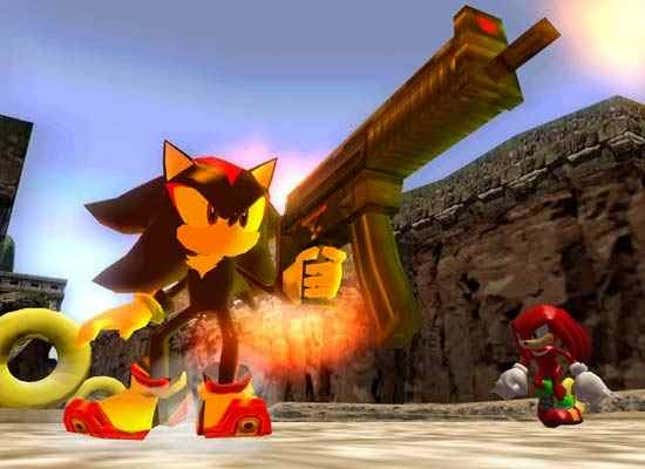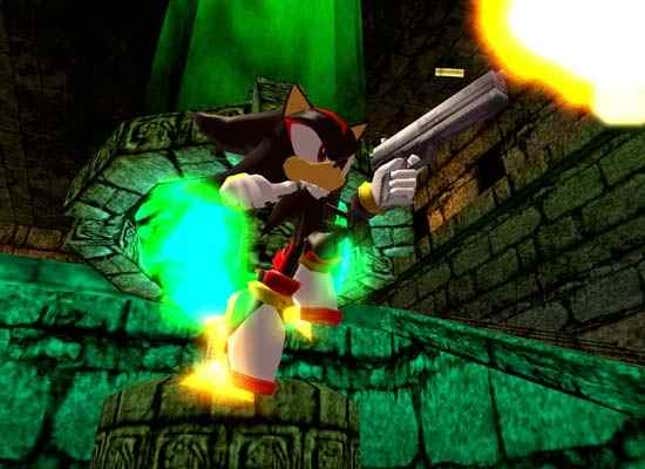It’s the Year of Shadow, a time to celebrate Sonic the Hedgehog’s brooding rival. While Shadow Generations gave the black-and-red hedgehog a starring role in a game this year, it wasn’t the first time that Shadow the Hedgehog got his own game. Today is November 15, and that means it’s been 19 years since Shadow the Hedgehog launched in 2005. The game was— and remains—one of the most widely derided games in the Sonic franchise, and nearly two decades later, I think some of that hate is deserved. However, I am ready to stand on my soapbox in this, the Year of Shadow, and say it had some interesting ideas.
When Shadow the Hedgehog is just being a standard 3D Sonic game, it’s a pretty solid one of those. Shadow runs, jumps, and homing-attacks his way through enemies and obstacle courses with the same exhilarating velocity he always has. Unfortunately, I don’t think it has many memorable levels, which could be part of the reason Shadow Generations doesn’t have any levels explicitly based on the game. But at its core, Shadow the Hedgehog is just as good as any other 3D Sonic game. Whether that sounds like a good time to you or not depends on how you feel about Sonic’s 3D outings in general, but I think Shadow the Hedgehog is an alright one of those.
The coolest thing about Shadow the Hedgehog is how it handles multiple endings. There’s a visual novel-esque quality to its story structure as Shadow goes through multiple timelines, learning different truths and ultimately coming to different conclusions about his past. Shadow the Hedgehog is one of the last gasps of Sonic’s AMV-bait era before things got sanded down after Sonic ‘06. The game gets into melodramatic explorations of Shadow’s self-concept, questions whether one’s value is defined by one’s past, and wonders if it’s possible to forge a new future, and all of this is structured around a flowchart. There are multiple endings exploring these themes, and which one you get is determined by good, evil, and neutral missions you can complete during the standard run-and-jump Sonic levels. Your choices will lead you to different conclusions, though in a more abstract way than you might be familiar with from narrative-driven games in which the way things play out often feels like a direct result of your actions. Here, it’s more like doing a bad thing relegates you to the lower end of the level select screen, leading you to one of 10 possible conclusions.

Some of these can result in Shadow finding out half-truths about himself. He might believe himself to be an android clone of the original hedgehog who debuted in Sonic Adventure 2, or become the right hand to his alien invader father Black Doom. Shadow the Hedgehog does have a true conclusion, but its use of multiple endings and choice-driven game design, which allows fans to explore the deep (if overly convoluted) backstory of the antihero, is a really compelling technique for a series that was getting increasingly mature during the mid-2000s. It feels like the natural evolution of the alternate story paths Sonic games had been utilizing during that era.
The problem is, that maturity takes a hard left turn into early-2000s edginess. Shadow wields firearms in this game and they are incredibly frustrating to use, lacking any kind of lock-on or aiming mechanic. Enemy health is scaled, too, so you’re wasting time if you don’t whip out a Glock or a rocket launcher to deal more damage than your homing attack can deliver. While not inherently “edgy,” Shadow can also drive vehicles, most of which are slower than he is on foot, in what feels like a half-assed effort to emulate more “mature” games like Grand Theft Auto. Occasionally these vehicles are used to greater effect, like the mech Shadow can pilot that lets him jump high through some of the platforming segments, but most of the time these cars and bikes are just hanging out in different levels with no incentive to use them. Surprisingly enough, the vehicles were kept around for Sonic ‘06, where they felt more integrated into the level design, at least sometimes. But even so, the weapons and vehicles came off like obligatory distractions from the decent core Sonic gameplay.
But the weirdest, most memeable thing about Shadow the Hedgehog is easily that characters swear. Soundbites like “Where’s that damn fourth Chaos Emerald?” with its incredibly forced delivery, are still iconic within the Sonic fandom, and I still have vivid, embarrassing memories of playing the game in my dad’s living room and seeing him wince every time Shadow said “damn” when I got hit by an enemy. Fearing your parent might take a game away from you if he thinks the mascot character is a potty mouth is as good a motivation as any to get good.

All of these creative decisions were made in service of an older audience, and in the moment, they felt forced and made Shadow the Hedgehog a worse game. But looking back on it, I still find a lot to love in the spaces between the nonsense. Shadow was always the emotional center of the franchise for me, so learning more about his ever-evolving lore through a video game story structure that was completely new to me as a kid was worth the online ridicule I endured for saying I liked the game. Crush 40’s theme song for the game, “I Am…All of Me” is still an S-tier track in a series full of them. And you can’t tell me it didn’t feel incredible to use Chaos Control and dash through entire levels at maximum velocity.
In retrospect, Shadow the Hedgehog is a pretty fascinating reflection of a moment in both the Sonic franchise and pop culture at large. The people behind Sonic were pressing the gas on the anime-inspired sentimentality that had been working for them, in the face of continued critical pressure to revert the series to a simple mascot platformer only focusing on the blue blur. But angst, edginess, and perceived “mature” storytelling were “in” during the mid-2000s. Plenty of franchises were trying to make their “gritty” pivot, like the Jak series and Prince of Persia, and some were more successful than others. Shades of this moment in the franchise are found in Shadow Generations, and it is certainly far more effective at capturing those ideas than Shadow the Hedgehog. But even given my criticisms, I look back on Shadow’s first game with fondness. It had ideas and it ran with them, even if where it ran was headfirst into a wall. As the Year of Shadow comes to a close, I’m glad to see Shadow getting his due with that newer game, one I can recommend without all the caveats.


